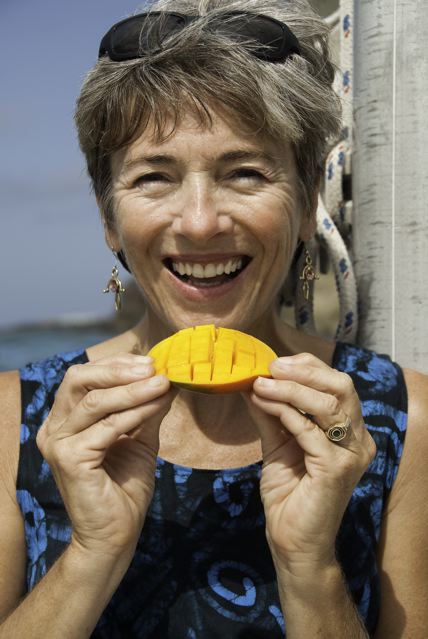
From Ann Vanderhoof’s An Embarrassment of Mangoes:
“ʻWould you like some mangoes?’ a woman’s voice sings out from across the road, as we stand and admire a tree that’s positively dripping ripe fruit.
Steve and I are in the middle of a game we play whenever we go for a walk lately: Let’s pretend we can buy a piece of property in Grenada; what would we choose? We have fallen in love with this island at 12 degrees north of the equator since arriving here a few weeks ago….
This sweet stretch of land, a sweat-breaking, fifteen-minute hike up the steep, potholed road from the dock at the village of Woburn, is a strong contender in our let’s-buy-some-island-property game. Along with the sweeping view of Clarke’s Court Bay and, beyond that, of Hog Island and Receta calmly at anchor, it promises more mangoes than we could possibly eat, as well as papayas, breadfruit, and coconuts….”
* * *
“It’s All About Contrast”
When I spot Ann Vanderhoof walking purposefully toward me across the cobbled square in Toronto’s Distillery Historic District, I’m surprised how petite she is. I recognize her face from a photo, but perhaps I had expected someone so adventurous — someone determined to leave behind the 9-to-5 for life on board a sailboat — to be, I don’t know … taller?
In fact she’s tiny and slim, with tanned skin, short, ruffled grey hair, sparkling eyes, and a wide smile. She’s dressed casually in patterned capris, a simple tank, and sandals, and around her neck hangs a glinting green necklace of seaglass and beads and nuts that I have a hard time taking my eyes off. (It’s called a mojo, she tells me when I ask, and it’s made by Sandra Preisig of Carriacou, www.fidelproductions.com.)
As we sit down to cold drinks outside Balzac’s coffee shop on this sunny summer day, I’m conscious of the bustle around us of locals and tourists, including a couple rolling by on Segways, and the noise of traffic and some sort of construction. I ask Ann whether she finds it jarring to be back here after a winter of sailing.
“It’s all about contrast,” says the freelance travel writer and author of two travel-and-food memoirs, “but I enjoy both. I turn more into an A type when I’m in the city.” Before she and husband Steve Manley went south that first time in 1997, “I almost didn’t brush my teeth without a deadline.”
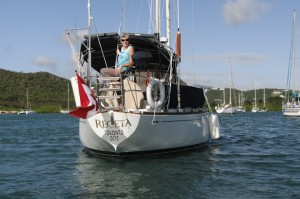
Ann on “Receta” (Photo: Steve Manley)
Sailing, she says, has changed her.
The author now spends the warm-in-Canada months with Steve in downtown Toronto, and the remainder of the year down south. Their starting point this year was Trinidad, and their northernmost stop Antigua. They spent Christmas and New Year’s in Trinidad (“no one does holidays like the Trinis”), caught their first wahoo, a 42-incher (“the most delicious fish we’ve cooked on Receta, ever”), and off the coast of Dominica, saw the spectacle of their first breaching humpback whale.
Contrast indeed.
So on a daily basis, what’s the biggest difference between these two aspects of her life? I ask.
Weather governs your time there, she explains, “waiting and watching for the weather to unfold…. I’ve learned to slow down, and to allow myself to take pleasure in the moment. I’ve learned you can’t plan everything…. I watch the sky, the clouds, the water changes, the moon. There’s deep pleasure in that.”
The Moment the Seed Was Planted
In her two travel memoirs, An Embarrassment of Mangoes: A Caribbean Interlude (2004) and The Spice Necklace: A Food-Lover’s Caribbean Adventure (2010), Ann shares some of these pleasures and her passion for the islands. Both books brim with her enthusiasm for the people she meets, and the sensory delights of travelling by water and preparing local dishes along the way. The recipes she includes have been tested in her tiny galley kitchen aboard Receta — everything from Stewed Lambi (conch) to Cream of Callaloo Soup to Piña Colada Cheesecake.
Food was important to her family when she was growing up, she says. She was raised in New Jersey by an Irish-Catholic mother and “a father who was the son of a rabbi.” Her grandfather owned a small Jewish-style deli.
Though she studied art history and museology in the U.S., when she moved to Toronto in 1979 she “somehow fell in love with publishing.” She worked for several years for a classical music magazine before being hired at Quill & Quire. She was eventually promoted to editor of that publishing-industry newsmagazine. In 1988, she became the founding editor of Cottage Life. Steve, whom she’d met a few years earlier when they played on the same softball team, was the publication’s founding art director.
She can pinpoint the moment the seed was planted. One cold, dreary winter evening in 1990, she trudged up their slushy front walk and into the house, fuming about a particularly tough workweek and about having left for work in the dark and now returning in the dark. Steve, who was feeling similarly frustrated, surprised her with the response “Well, why don’t we plan to take two years off and go sailing.”
Ann’s first thought? That he was nuts. For starters, although Steve, who’d grown up in Lakefield, Ontario, had experience sailing, Ann had almost none. The first time she’d set foot on a sailboat was on one of their early dates. And then there was the cost of such a venture.
But dreaming of escaping the winter cold and snow is something at which Canadians excel, and after further discussion she and Steve came up with a Five-Year Plan, one that required a dedicated commitment to fiscal restraint, saving, and paying off their mortgage.
The fact they didn’t have children simplified things, she says, but nevertheless there was much to learn, and a sailboat to find, buy, and equip. The Five-Year Plan evolved into the Seven-Year Plan.
Ann admits that at the outset she wasn’t convinced they’d actually follow through and go sailing. She thought they should do something else during their time away. But gradually she warmed to the idea.
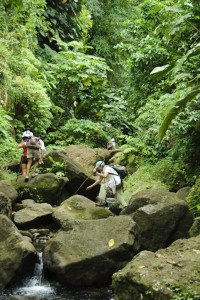
Hiking to Fontainebleu Falls in Grenada (Photo: Steve Manley)
The couple stayed in Toronto to see the publication of the tenth-anniversary issue of Cottage Life and then they set sail on the 42-foot sailboat they dubbed Receta — Spanish for “recipe.” The first leg of the journey was 844 miles to the south end of Chesapeake Bay, and from there they pushed on to the Caribbean.
They would sail for a total of two years.
In Mangoes, she describes the first part of the trip as “a relentless barrage of new places, new people, and new problems. Every day, in fact, brings a new situation to be tackled, something that didn’t previously exist in my limited repertoire of boating skills.”
She knows many people see her and Steve as “living the dream,” but sailing, she tells me, “isn’t all about lying on a beach all day sipping rum drinks. It is a lifestyle choice, and often it’s hard work…. A sailboat is like a house but with a lot more maintenance issues,” including power generation, water desalination, and in more remote areas, trash management.
Yet the challenges have also “opened up a problem-solving part of my brain…. It’s an adventure. Every day brings something new — it’s completely unpredictable. Sometimes I don’t know what we’ll have for dinner until I hear the call of the conch horn from the market.”
Writing What She Really Wanted to Write
When they set out on that first trip, Ann had no thought of penning a book. It wasn’t until they’d returned home in the fall of 1999 and she was freelancing that Steve suggested she take time to write what she “really wanted to write.”
On board Receta she had kept three different logs/journals. The first recorded only the daily weather. The second, the ship’s log, contained the “hourly nuts and bolts” of the journey while they were on passage. The third was her own daily journal and it had grown to enormous proportions, she says; printed out, it was “like a sea anchor.” The latter was to become a valuable resource for her first travel memoir, An Embarrassment of Mangoes.
Ann says she had to write first for herself. “I couldn’t have written it any other way. I didn’t want to worry about how other people would react.” And she derived great pleasure from reliving their time in the Caribbean. “The writing took me away again. The phone would ring and for me it would be like coming back from a place far away.”
Steve eventually tacked a sign to her office door: “TAKE TIME TO LIME.”* (“To lime” is a Trinidadian term meaning “to idle.”)
Ann pondered what sort of book she wanted hers to be. She didn’t want to write one for sailors, nor did she want to write a how-to. She wanted it to be personal, but the mammoth journal she’d kept was in the present tense and contained little reflection.
On top of that, she now found some of her early entries disappointingly “whiny.” Those early days of sailing were hard, she says: dealing with tides, feeling cold and wet a lot of the time, fixing leaks. She knew the book she wrote would have to balance the realities and the allure.
What evolved was the story of how she and Steve decided to quit their jobs, downsize, and set off; of what they discovered in the islands, and how the journey changed their image of themselves.
She said it helped to read passages out loud to herself as she wrote, to see how they sounded. And she paid attention to what she knew were her own weaknesses as a writer, which included using too many parentheses and repeating certain “crutch” words. As a reminder, above her desk she pinned her personal “List of Banned Words.” Writing about food is more difficult than it seems, she explains; it means constantly looking for unique ways to describe taste, smell, and texture.
Another challenge was writing about Steve. Knowing him so well, she often neglected to describe him on the page even though he was integral to her stories.
He’s also integral to her writing. He’s her “secret weapon,” she confides. He always reads her work and has — and she means this in the best possible way — “no editorial bedside manner.”
Ann’s second book, The Spice Necklace, is about their second Caribbean sojourn, which came about as the result of another Seven-Year Plan and lasted three years, from 2006 to 2008. If the first book is about “getting there,” she says, the second is about “being there.”
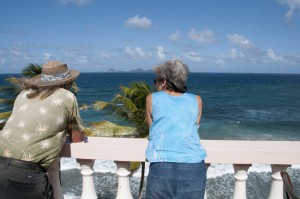
Ann with cruising friend Chris enjoying view from Petite Anse Hotel in Grenada (Photo: Steve Manley)
Known as the Isle of Spice, Grenada has more spices per square mile than any other place on earth, and in the St. George’s market, women string together nutmeg, mace, cloves, bay leaves, exotic beans, cocoa beans, and cinnamon bark to form aromatic necklaces. In The Spice Necklace, Ann uses the necklace as a metaphor for the Caribbean islands chain, with chapters focusing on different aspects of island cooking and culture.
Asked which Caribbean island she likes best, Ann replies, without hesitation, “Grenada. Pulling into anchorage there always feels like coming home.”
But after a moment of reflection, she adds, as any true traveller would, “Wherever I am at the time is my favourite island.”
“I’m Out Here Because of You”
Sailing has brought Ann a greater confidence in herself, the result of having faced down the challenges of the lifestyle — including sailing at night, which originally terrified her. But even more important, she says, “Being on the boat has brought out sides of ourselves we like best.”
As for the writing, nothing brings her more pleasure than meeting people sailing the islands who tell her, “I read your book and I’m out here because of you.”
She knows that it’s not everyone’s dream to live on a sailboat — that there are endless variations on the Big Dream. But she hopes the story of how she and her husband took a calculated risk and changed their lives may inspire others, too, to make their dreams a reality.
Ann and I suddenly realize that we’ve talked twice as long as we’d planned. How can one possibly fit into a couple of hours all there is to ask and tell about exotic travel and food and writing and eye-catching necklaces of seaglass and beads and nuts?
After we part and head in opposite directions, I glance back to see “A-type,” city Ann hurrying off to her next appointment. She’s a busy freelance writer, contributing regularly to travel magazines such as Islands, and she maintains a blog, also called The Spice Necklace. She’s also a sought-after speaker on the interrelated subjects that bring her a happiness she loves to share: sailing, travel, cooking, and writing.
But Receta is waiting patiently in Trinidad, and soon Ann and Steve will be back on board, among the islands, watching the weather unfold and listening for the call of the conch horn from the market.
* * *
For more about Ann and her travel adventures, visit The Spice Necklace.
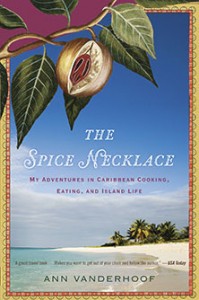
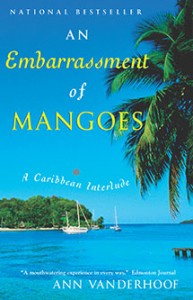
Having met Ann through you, Allyson, I recall her enthusiasm for the islands and the wonderful recipes she discovered due to a curiosity about each island’s culture. In fact, Ann bubbled over with valuable information about how to make the dream attainable. I remember the spices she brought for us to smell. And we peppered her with questions: Were you ever afraid for your life? Did you and Steve get along in close quarters? What adjustments had to be made for downsizing to a small cabin?
It was evident how in love she was with the island-hopping lifestyle, treating it as an opportunity to learn authentic recipes from islanders who became her friends.
No better person could have recommended the Petite Anse Hotel in Grenada for your writers’ retreat in 2013. Tempting.
I knew Steve from the early 1980s, when we both worked at Canadian Business magazine. Imagine my pleasant surprise when I opened Ann’s first memoir, which I had plucked off the shelf in our small local library, and realized the author was Steve’s wife. It’s a beautiful book (I have recommended it to many friends, and have re-read it at least four times since then). I ordered Ann’s second book just the other day, and am looking forward to reading and sharing it, as well.